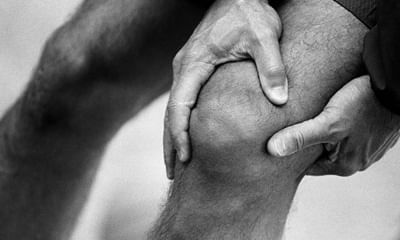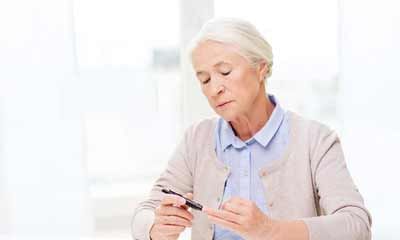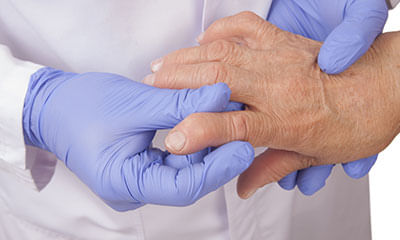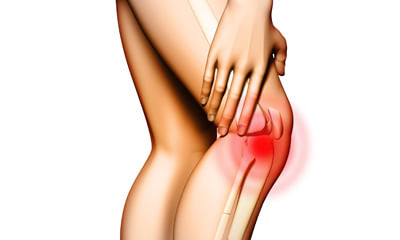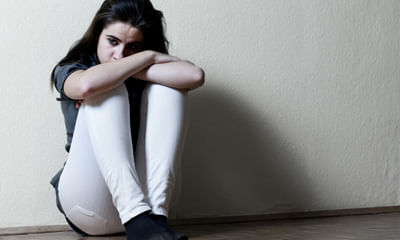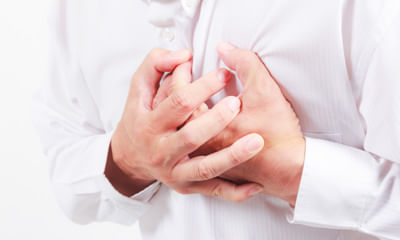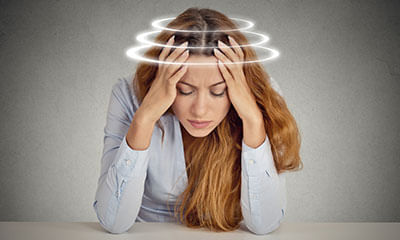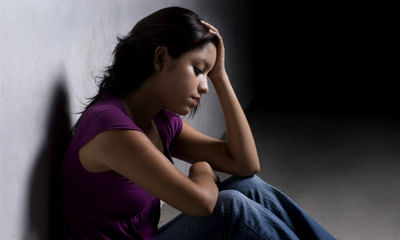Weak Hands In The Morning
Hi I had acl surgery with bio screw hamstring and it's been 8 weeks now. I am not able to fully extend my knee differenc ...
Ask Free Question
Knee ligament laxity if you have problem in your legs then it might be due to ligament laxity where your legs would become very weak due to the old ligament injury and that should be treated immediately. Wear knee cap so that you will feel firm while walking or climbing stairs. This is a general strain and for this you can follow these measures: one keep a pillow right under the knee while sleeping, next is you can keep ice in the painful area for about 5--10 minutes, if pain still persists you can stretch your body by twisting the waist on both sides how we used to do in the school drill similarly you can try! one time you can do hot water fermentation that would help to reduce the muscle strain. You have to do knee strengthening exercises, ie. Knee rehabilitation exercises which will strengthen your knee. Exercises will give you permanent cure than the surgery. Physiotherapy management :you can take ultrasonic therapy in one of the nearby physiotherapy clinics which would help to heal the damaged cartilages along with shortwave diathermy which would help to improve the blood circulation. Knee pain: resisted terminal knee extension: make a loop with a piece of elastic tubing by tying a knot in both ends. Close the knot in a door at knee height. Step into the loop with your injured leg so the tubing is around the back of your knee. Lift the other foot off the ground and hold onto a chair for balance, if needed. Bend the knee with tubing about 45 degrees. Slowly straighten your leg, keeping your thigh muscle tight as you do this. Repeat 15 times. Do 2 sets of 15. If you need an easier way to do this, stand on both legs for better support while you do the exercise. Standing calf stretch: stand facing a wall with your hands on the wall at about eye level. Keep as arthritis is very common that you get generally bilaterally. Ice therapy would definitely help to reduce the inflammation. We also advise you to use knee cap which would help to prevent the knee from damaging further and also to maintain the quadriceps muscle tone knee pain, when leg folding time get pain. This must be due to your muscular strain and posture and it may not be due to any other reasons. It is better to correct your addictive behaviour by consulting the right physician. For the time being for the back pain, apply ice.Neck tilt: from the sitting position, tilt your head down so your chin touches your chest. Hold this position for 5 second s. Return to the starting position and repeat. Do this five times. Side-to-side neck tilt. From the same starting position, tilt you neck toward one shoulder, leading with your ear. Hold for 5 seconds and then return to the starting position. Do this five times on each side. Neck turn. Look straight ahead, then turn your head to one side, keeping your chin at the same level. Do this five times on each side. Neck stretch. Holding the rest of your body straight, push your chin forward, stretching your throat. Hold for 5 seconds. From the same starting position, push your chin backward and hold for 5 seconds. Do the forward and backward stretch five times each. If any of these exercises cause severe pain or weakness in your hands or arms, stop right away and talk with your doctor the importance of buying braces and splints from us – orthopaedic support braces we suggest you to wear knee brace which is available at our clinic. If you want you can buy from us, if you are far away from chennai we can send you by courier. The reason why we are conveying you to buy from us is we can demonstrate over the videocall (using whatsapp) and also we can monitor you throughout when to wear it and how long to wear it. And also if you find any difficulty wearing the brace you can also revert back to us for few more suggestions and we can propose you good solution how to go about it.
Doctor my mother has osteoarthritis is it curable its in initial stage is it curable and may I know how long it takes to ...
Ask Free Question
Symptoms of arthritis symptoms of osteoarthritis may include joint pain and progressive stiffness that develops gradually. Symptoms of may include painful swelling, inflammation, and stiffness in the fingers, arms, legs, and wrists occurring in the same joints on both sides of the body, especially upon waking up in the morning. Knee arthritis can be painful and debilitating. For osteoarthritis (oa) of the knee, self-care early on can often help significantly. It is important to stretch and strengthen the surrounding leg muscles to provide more support and reduce stresses around the joint. The following best bet exercises will help you get started on your path to feeling stronger, more flexible and more active. Remember: exercise should not be painful – if you experience pain, discontinue and consult with your physician. Advice: 1.must take adequate rest 2.apply hot water with mild heat with cotton towel 3.avoid cross leg sitting and long time standing 4. Put the small size chair under the ankle during sitting in the chair for leg elevation 5.do the exercise given below 2 times per day 1.quadriceps setting exercise helps to strengthen the quadriceps muscle (the big muscle on the front of the thigh), an important stabilizer of the knee. Lie on your back with the leg you want to exercise straight. Place a small rolled towel underneath the knee. Slowly tighten the muscle on top of the thigh (quadriceps) and push the back of the knee down into the rolled towel. Hold contraction for 5 seconds and then slowly release, resting 5 seconds between each contraction. Perform 3 sets of 10 repetitions, 1 time daily. 2.straight leg raise also helps to strengthen the quadriceps muscle. Lie on your back with the leg you want to exercise straight. The other knee should be bent to support your lower back. Tighten the muscle on the top of your thigh and lift to the level of your other knee. Slowly lower. Perform 3 sets of 10 repetitions, 1 time daily. Knee pain •patellar tendinitis: •risk factor •a combination of factors may contribute to the development of patellar tendinitis, including: •physical activity. •running and jumping are most commonly associated with patellar tendinitis. Sudden increases in how hard or how often you engage in the activity also add stress to the tendon, as can changing your running shoes. •tight leg muscles. Tight thigh muscles (quadriceps) and hamstrings, which run up the back of your thighs, can increase strain on your patellar tendon. •muscular imbalance. •if some muscles in your legs are much stronger than others, the stronger muscles could pull harder on your patellar tendon. This uneven pull could cause tendinitis. •chronic illness. •some illnesses disrupt blood flow to the knee, which weakens the tendon. Examples include kidney failure, autoimmune diseases such as lupus or rheumatoid arthritis and metabolic diseases such as diabetes. •complications •if you try to work through your pain, ignoring your body's warning signs, you could cause increasingly larger tears in the patellar tendon. Knee pain and reduced function can persist if you don't tend to the problem, and you may progress to the more serious patellar tendinopathy. •prevention •to reduce your risk of developing patellar tendinitis, take these steps: •don't play through pain. As soon as you notice exercise-related knee pain, ice the area and rest. Until your knee is pain-free, avoid activities that put stress on your patellar tendon. •strengthen your muscles. Strong thigh muscles are better able to handle the stresses that can cause patellar tendinitis. Eccentric exercises, which involve lowering your leg very slowly after extending your knee, are particularly helpful. •improve your technique. To be sure you're using your body correctly, consider taking lessons or getting professional instructions when starting a new sport or using exercise equipment. •therapy •a variety of physical therapy techniques can help reduce the symptoms associated with patellar tendinitis, including: •patellar tendon strap. A strap that applies pressure to your patellar tendon can help to distribute force away from the tendon and direct it through the strap instead. This may help relieve pain. •iontophoresis. This therapy involves spreading a corticosteroid medicine on your skin and then using a device that delivers a low electrical charge to push the medication through your skin. •platelet-rich plasma injection. This type of injection has been tried in some people with chronic patellar tendon problems. Studies are ongoing. It is hoped the injections might promote new tissue formation and help heal tendon damage. •probably your stamina would've gone down due to over use of the joints and the metabolic activity is more due to running. You need to consume good protein diet so that your body will act as a reservoir. It will help you to fight against rather than affecting one particular area of your body for eg. Knee joint. For knee ligament pain or inflammation you need to keep ice which will help you to prevent the inflammation progressing further. •patellofemoral pain syndrome •usually fully relieved with simple measures or physical therapy. It may recur, however, if you do not make adjustments to your training routine or activity level. It is essential to maintain appropriate conditioning of the muscles around the knee, particularly the quadriceps and the hamstrings. •there are additional steps that you can take to prevent recurrence of patellofemoral •they include: •wearing shoes appropriate to your activities •warming up thoroughly before physical activity •incorporating stretching and flexibility exercises for the quadriceps and hamstrings into your warm-up routine, and stretching after physical activity •increasing training gradually •reducing any activity that has hurt your knees in the past •maintaining a healthy body weight to avoid overstressing your knees •joints, ie. In the upper limbs if the pain is present in the fingers/wrist and in the lower limbs it the pain is present in the toes/ ankle, then we shall definitely say it is rheumatic arthritis. •if your proximal joints (ie. Shoulder, hip & knee has pain) then you can pour hot (warm) water in that area to reduce the inflammation. If you have pain in the distal joints ie. Wrist, fingers, ankle, toes then you can wear either elbow brace or wrist brace which will help you to feel warm and very protective. And also immerse the distal joints in the hot water tub which will help you to reduce the pain. •knee pain during driving or watching movie. •it might due to lack of movements in the knee while the joints are immobilized during driving and while watching movies. It is important that you need to have movements in and around the knee so that the blood flow will not be disturbed. •knee ligament laxity•if you have problem in your legs then it might be due to ligament laxity where your legs would become very weak due to the old ligament injury and that should be treated immediately. •wear knee cap so that you will feel firm while walking or climbing stairs.•this is a general strain and for this you can follow these measures: one keep a pillow right under the knee while sleeping, next is you can keep ice in the painful area for about 5--10 minutes, if pain still persists you can stretch your body by twisting the waist on both sides how we used to do in the school drill similarly you can try! one time you can do hot water fermentation that would help to reduce the muscle strain. •legs becoming numb and also pain is there when the patient walks for 10-15 minutes?•it looks like you are anaemic. If you feel that the legs are becoming numb then keep your legs warm which is important, probably you can wear mcr chappals inside the house/ socks inside the house. Put a door mat when ever you sit so that you will feel comfortable. Also pour warm water in the legs which would help you to get better circulation. •knee pain. If you are overweight, losing weight will also help to reduce pressure on your knee. Knee pain this is a general knee pain and for this you can follow these measures: one keep a pillow right under the knee while sleeping, next is you can keep ice in the painful area for about 5--10 minutes, it looks like you are is important to check that. Anaemia always leads to the symptoms of being tired and also having body pain though there may not be any pathological reasons for knee pain. With knee exercises you will definitely feel better and muscles must be strengthened .•don't play through pain. As soon as you notice exercise-related knee pain, ice the area and rest. Until your knee is pain-free, avoid activities that put stress on your patellar tendon. •strengthen your muscles. Strong thigh muscles are better able to handle the stresses that can cause patellar tendinitis. Eccentric exercises, which involve lowering your leg very slowly after extending your knee, are particularly helpful. •improve your technique. To be sure you're using your body correctly, consider taking lessons or getting professional instructions when starting a new sport or using exercise equipment. •therapy •a variety of physical therapy techniques can help reduce the symptoms associated with patellar tendinitis, includingback pain it looks like you are anaemic. If you have back pain after you sit for long hours then it is due to your haemoglobin levels as it is important to check that. Anaemia always leads to the symptoms of being tired and also having back / leg pain though there may not be any pathological reasons for back pain. It looks like you are anaemic. And also you have to check with your vitamin and calcium, if the bones are weak then automatically the pain gets triggered more as there is less severity of the painbe strengthened 1.resisted terminal knee extension: make a loop with a piece of elastic tubing by tying a knot in both ends. Close the knot in a door at knee height. Step into the loop with your injured leg so the tubing is around the back of your knee. Lift the other foot off the ground and hold onto a chair for balance, if needed. Bend the knee with tubing about 45 degrees. Slowly straighten your leg, keeping your thigh muscle tight as you do this. Repeat 15 times. Do 2 sets of 15. If you need an easier way to do this, stand on both legs for better support while you do the exercise. 2•standing calf stretch: stand facing a wall with your hands on the wall at about eye level. Keep as arthritis is very common that you get generally bilaterally. Ice therapy would definitely help to reduce the inflammation. We also advise you to use knee cap which would help to prevent the knee from damaging further and also to maintain the quadriceps muscle tone •stretching exercises. Regular, steady stretching exercises can reduce muscle spasm and help lengthen the muscle-tendon unit. Don't bounce during your stretch. 3•strengthening exercises. Weak thigh muscles contribute to the strain on your patellar tendon. Exercises that involve lowering your leg very slowly after extending it can be particularly helpful, as can exercises that strengthen all of the leg muscles in combination, such as a leg press.•this is a general knee pain and for this you can follow these measures: one keep a pillow right under the knee while sleeping, next is you can keep ice in the painful area for about 5--10 minutes, it looks like you are is important to check that. Anaemia always leads to the symptoms of being tired and also having body pain though there may not be any pathological reasons for knee pain. With knee exercises you will definitely feel better and muscles must be strengthened.
Hi, I am suffering from rheumatoid arthritis for 2 years and the allopathy doctor suggested taking redimard (iguratimod ...
Ask Free Question
Rheumatoid arthritis multiple joint pains / early morning painit is called as rheumatic arthritis. Treatment goals •to protect the joint from further damages. •provide pin relief. •prevent deformity and disabilities. •increase functional capacity. •improve flexibility and strength. •encourage regular exercise. •improve general fitness. Physiotherapy modalities - hot/cold applications- electrical stimulation- hydrotherapy and spa therapy rehabilitation treatment technique - rest and splinting - compression gloves - assistive devices and adaptive equipment - massage therapy - therapeutic exercise - patient education assistive devices and adaptive equipment occupational therapy improves functional ability in patients with ra. Occupational therapy interventions such as assistive devices and adaptive equipments have beneficial effects on joint protection and energy conservation in arthritic patients. Assistive devices are used in order to reduce functional deficits, to diminish pain, and to keep patients' independence and self-efficiency. Loading over the hip joint may be reduced by 50% by holding a cane. In fact, most of these instruments are originally designed for patients with neurologic deficits; therefore, certain adaptations may be needed for them to be used in patients with arthritis. Elevated toilet seats, widened gripping handles, arrangements related with bathrooms, etc. Might all facilitate the daily life. The procedures needed to increase compliance of the patient with the environment and to increase functional independence are +mainly determined by the occupational therapist. Massage therapy that improves flexibility, enhances a feeling of connection with other treatment modalities, improves general well being, and can help to diminish swelling of inflamed joints. Massage is found to be effective on depression, anxiety, mood, and pain. Therapeutic exercise every joint should be moved in the rom at least once per day in order to prevent contracture. In the case of acutely inflamed joints, isometric exercises provide adequate muscle tone without exacerbation of clinical disease activity. Moderate contractures should be held for 6 seconds and repeated 5–10 times each day. Dynamic exercise therapy in improving joint mobility, muscle strength, aerobic capacity and daily functioning in patients with rheumatoid arthritis (ra). Finally, in chronic stage with inactive arthritis, conditioning exercises such as swimming, walking, and cycling with adequate resting periods are recommended. They increase muscle endurance and aerobic capacity and improve functions of the patient in general, and they also make the patient feel better. It might be due to lack of blood circulation which is the reason for you to have scrotum pain / back pain. You have to do basic aerobic exercises for you to become fit and also to maintain the blood circulation and tone. Patient education in patients with ra, sociopsychological factors affecting the disease process such as poor social relations, disturbance of communication with the environment, and unhappiness and depression at work are commonly encountered. The treatment of rheumatic diseases should provide education and information to their patients about their condition and the various physical therapy and rehabilitative options that are available to improve their quality of life. Passive treatments for rheumatoid arthritis •cold therapy reduces circulation, which ultimately decreases swelling. For example, a cold compress may be placed on the painful area. •cold therapy in acute phase •dosage 10-20mints/1-2 times a day. •heat therapy eases muscle tension and gets blood to flow more quickly to the painful area. For example, a moist, warm cloth may be used to promote circulation. •heat therapy in chronic phase •dosage 20-30mints/1-2 times a day. •hydrotherapy involves reducing your ra-related pain and other symptoms with water. With hydrotherapy, you will be submerged in warm water to relieve your symptoms. •massage can help reduce muscle tension and promote good circulation. It's also a fantastic way to help you manage stress (especially important for people with rheumatoid arthritis). •transcutaneous electrical nerve stimulation (tens) works by blocking pain signals from getting to your spinal cord. It also helps decrease muscle spasms. •tens short term pain relief (6 to 18 hrs) •ultrasound creates warmth using sound waves, whichenchanes circulation and decreases joint pain, inflammation, and stiffness. Exercise for acute phase: •preformed exercise at least once a day. •general assisted movement through normal range (joint mobilisation). •isometric-“static movements” helps to maintain muscle tone without increasing inflammation. Exercise for the chronic phase: •can progress the above exercise to include use of light resistance. •postural/core stability exercises. •swimming/walking/cycling to maintain cardiovascular fitness. •gentle stretch for areas that become tight, such as knees &calves. Regular exercises: •maintaing muscle strength is important for joint stability & preventing injury. •muscles can become weak following reduced activity. •pain signals from yours nerves and swelling can both inhibits muscles. •muscle length can be affected by prolonged positions immobilization and tightness can limit daily activities. Alternative therapies: •thi chi. •musical therapy. •yoga therapy. •relaxation techniques.
I am 19 years old male and have been a pain in the left knee specifically. The left knee pops almost all the time. It pa ...
Ask Free Question
Knee pain this is a general knee pain and for this you can follow these measures: one keep a pillow right under the knee while sleeping, next is you can keep ice in the painful area for about 5--10 minutes, it looks like you are is important to check that. Anaemia always leads to the symptoms of being tired and also having body pain though there may not be any pathological reasons for knee pain. With knee exercises you will definitely feel better and muscles must be strengthened .•don't play through pain. As soon as you notice exercise-related knee pain, ice the area and rest. Until your knee is pain-free, avoid activities that put stress on your patellar tendon. •strengthen your muscles. Strong thigh muscles are better able to handle the stresses that can cause patellar tendinitis. Eccentric exercises, which involve lowering your leg very slowly after extending your knee, are particularly helpful. •improve your technique. To be sure you're using your body correctly, consider taking lessons or getting professional instructions when starting a new sport or using exercise equipment. •therapy •a variety of physical therapy techniques can help reduce the symptoms associated with patellar tendinitis, includingback pain it looks like you are anaemic. If you have back pain after you sit for long hours then it is due to your haemoglobin levels as it is important to check that. Anaemia always leads to the symptoms of being tired and also having back / leg pain though there may not be any pathological reasons for back pain. It looks like you are anaemic. And also you have to check with your vitamin and calcium, if the bones are weak then automatically the pain gets triggered more as there is less severity of the painbe strengthened 1.resisted terminal knee extension: make a loop with a piece of elastic tubing by tying a knot in both ends. Close the knot in a door at knee height. Step into the loop with your injured leg so the tubing is around the back of your knee. Lift the other foot off the ground and hold onto a chair for balance, if needed. Bend the knee with tubing about 45 degrees. Slowly straighten your leg, keeping your thigh muscle tight as you do this. Repeat 15 times. Do 2 sets of 15. If you need an easier way to do this, stand on both legs for better support while you do the exercise. 2•standing calf stretch: stand facing a wall with your hands on the wall at about eye level. Keep as arthritis is very common that you get generally bilaterally. Ice therapy would definitely help to reduce the inflammation. We also advise you to use knee cap which would help to prevent the knee from damaging further and also to maintain the quadriceps muscle tone •stretching exercises. Regular, steady stretching exercises can reduce muscle spasm and help lengthen the muscle-tendon unit. Don't bounce during your stretch. 3•strengthening exercises. Weak thigh muscles contribute to the strain on your patellar tendon. Exercises that involve lowering your leg very slowly after extending it can be particularly helpful, as can exercises that strengthen all of the leg muscles in combination, such as a leg press.•this is a general knee pain and for this you can follow these measures: one keep a pillow right under the knee while sleeping, next is you can keep ice in the painful area for about 5--10 minutes, it looks like you are is important to check that. Anaemia always leads to the symptoms of being tired and also having body pain though there may not be any pathological reasons for knee pain. With knee exercises you will definitely feel better and muscles must be strengthened.
I am 43 years old woman. I had depression problem 4-5 years back due to sudden death of family member. I used to feel ex ...
Ask Free Question
Hi lybrate-user. I'm sorry for your loss. Sounds like the stress and uneasiness is taking a physical toll on you as well. Chronic stress can lead to fatigue and weakness. It seems like the accident triggered some of thoughts about the unresolved stress unconsciously. You can explore how you've been thinking lately and how the accident has impacted your thoughts, feelings and behaviors. Engaging in relaxation techniques such as yoga, breathing and meditation or simply investing some time in whatever you enjoy can help calm your system. Also, remember it's okay to feel stressed after an accident. One important part of processing emotions is to stay rather than fight it. Do let me know if you wish to explore this further.
What kind of doctor should I see for a chest rib pain my rib to the sternum and rib to the backbone joints hurt early in ...
Ask Free Question
Belly breathing exercise (diaphragmatic breathing) lie on your back with your knees up and completely relax. Place one hand on your chest and the other on your belly. Breath in through your nose taking in as much air as you comfortably can and allow the hand on your belly to raise higher than the one on the chest (this shows that air is being pulled into the base of your lungs). Hold for up to 7 seconds and then slowly breathe out through the mouth for up to 8 seconds (contract your belly muscles to fully release as much air as possible). Try and perform a set of 5 of these every 10-15 seconds. You can perform this 5-10 times per day. Seated belly breathing exercise (diaphragmatic breathing) whilst seated with good posture place one hand on your chest and the other on your belly. Breath in through your nose taking in as much air as you comfortably can and allow the hand on your belly to raise higher than the one on the chest (this shows that air is being pulled into the base of your lungs). Hold for up to 7 seconds and then slowly breathe out through the mouth for up to 8 seconds (contract your belly muscles to fully release as much air as possible). Try and perform a set of 5 of these every 10-15 seconds. You can perform this 5-10 times per day. Myofascial self-massage for chest pain myofascial release techniques can help you release tightness in your chest area, which relaxes your chest muscles. Relieves tender spots in your thoracic spine stand with your back to the wall. Place the ball 08 to the side of your spine, on a line with the bottom of your shoulder blade. Roll up along the area between your spine and your shoulder blade, until you get to the junction between your shoulder and neck. Chest stretching exercises: mobilizes your thoracic spine lie on your side on the floor. Stretch out the lower leg and place the top knee onto the blackroll® at a 90-degree angle. Activation and strengthening exercises for chest pain when you’ve worked to tackle the symptoms of your chest tightness, you should work on your posture. That’s because your chest pain probably started from poor posture or muscle imbalances. With the following exercises, you’ll therefore train the muscles that tend to get weaker. Chest pain exercise: activates your shoulder blades secure the multi band in front of you at hip height and hold one of the loops. With the leg from the same side, lower down onto the knee, placing it directly below your hip. Stretches upper back side-bend stretch stand up straight with your arms on your sides and side bend your upper back only as far as comfortable to one side, hold for 3 seconds and then and repeat to the other side. Concentrate your stretch through your upper back. Perform 10 stretches, three times per day. Horizontal rolled up towel upper back stretch (thoracic mobilisation) place a rolled up towel horizontally under your upper back and rest. Allow the weight of your head and neck and low back to create a gentle stretch through the vertebrae of your upper back. Enhance the stretch by taking deep breaths. Perform this stretch for 3-10 minutes.
My mother have rheumatoid arthritis since 5 year. Now she get unbearable join pain. In last 6 month she has medical hist ...
Ask Free Question
The "normal" range (or negative test result) for rheumatoid factor is less than 14 iu/ml. Any result with values 14 iu/ml or above is considered abnormally high, elevated, or positive. Treatmentthere is no cure for rheumatoid arthritis. But clinical studies indicate that remission of symptoms is more likely when treatment begins early with medications known as disease-modifying antirheumatic drugs (dmards). Medicationsthe types of medications recommended by your doctor will depend on the severity of your symptoms and how long you've had rheumatoid arthritis. •nsaids. Nonsteroidal anti-inflammatory drugs (nsaids) can relieve pain and reduce inflammation. Over-the-counter nsaids include ibuprofen (advil, motrin ib) and naproxen sodium (aleve). Stronger nsaids are available by prescription. Side effects may include stomach irritation, heart problems and kidney damage. •steroids. Corticosteroid medications, such as prednisone, reduce inflammation and pain and slow joint damage. Side effects may include thinning of bones, weight gain and diabetes. Doctors often prescribe a corticosteroid to relieve acute symptoms, with the goal of gradually tapering off the medication. •disease-modifying antirheumatic drugs (dmards). These drugs can slow the progression of rheumatoid arthritis and save the joints and other tissues from permanent damage. Common dmards include methotrexate (trexall, otrexup, others), leflunomide (arava), hydroxychloroquine (plaquenil) and sulfasalazine (azulfidine). Side effects vary but may include liver damage, bone marrow suppression and severe lung infections. •biologic agents. Also known as biologic response modifiers, this newer class of dmards includes abatacept (orencia), adalimumab (humira), anakinra (kineret), baricitinib (olumiant), certolizumab (cimzia), etanercept (enbrel), golimumab (simponi), infliximab (remicade), rituximab (rituxan), sarilumab (kevzara), tocilizumab (actemra) and tofacitinib (xeljanz). These drugs can target parts of the immune system that trigger inflammation that causes joint and tissue damage. These types of drugs also increase the risk of infections. In people with rheumatoid arthritis, higher doses of tofacitinib can increase the risk of blood clots in the lungs. Biologic dmards are usually most effective when paired with a nonbiologic dmard, such as methotrexate. Therapy your doctor may send you to a physical or occupational therapist who can teach you exercises to help keep your joints flexible. The therapist may also suggest new ways to do daily tasks, which will be easier on your joints. For example, you may want to pick up an object using your forearms. Assistive devices can make it easier to avoid stressing your painful joints. For instance, a kitchen knife equipped with a hand grip helps protect your finger and wrist joints. Certain tools, such as buttonhooks, can make it easier to get dressed. Catalogs and medical supply stores are good places to look for ideas. Surgeryif medications fail to prevent or slow joint damage, you and your doctor may consider surgery to repair damaged joints. Surgery may help restore your ability to use your joint. It can also reduce pain and improve function. Rheumatoid arthritis surgery may involve one or more of the following procedures: •synovectomy. Surgery to remove the inflamed lining of the joint (synovium) can be performed on knees, elbows, wrists, fingers and hips. •tendon repair. Inflammation and joint damage may cause tendons around your joint to loosen or rupture. Your surgeon may be able to repair the tendons around your joint. •joint fusion. Surgically fusing a joint may be recommended to stabilize or realign a joint and for pain relief when a joint replacement isn't an option. •total joint replacement. During joint replacement surgery, your surgeon removes the damaged parts of your joint and inserts a prosthesis made of metal and plastic. Surgery carries a risk of bleeding, infection and pain. Discuss the benefits and risks with your doctor. Rheumatoid arthritis multiple joint pains / early morning painit is called as rheumatic arthritis. Treatment goals •to protect the joint from further damages. •provide pin relief. •prevent deformity and disabilities. •increase functional capacity. •improve flexibility and strength. •encourage regular exercise. •improve general fitness. Physiotherapy modalities - hot/cold applications- electrical stimulation- hydrotherapy and spa therapy rehabilitation treatment technique - rest and splinting - compression gloves - assistive devices and adaptive equipment - massage therapy - therapeutic exercise - patient education assistive devices and adaptive equipment occupational therapy improves functional ability in patients with ra. Occupational therapy interventions such as assistive devices and adaptive equipments have beneficial effects on joint protection and energy conservation in arthritic patients.Assistive devices are used in order to reduce functional deficits, to diminish pain, and to keep patients' independence and self-efficiency. Loading over the hip joint may be reduced by 50% by holding a cane. In fact, most of these instruments are originally designed for patients with neurologic deficits; therefore, certain adaptations may be needed for them to be used in patients with arthritis. Elevated toilet seats, widened gripping handles, arrangements related with bathrooms, etc. Might all facilitate the daily life. The procedures needed to increase compliance of the patient with the environment and to increase functional independence are +mainly determined by the occupational therapist. Massage therapy that improves flexibility, enhances a feeling of connection with other treatment modalities, improves general well being, and can help to diminish swelling of inflamed joints. Massage is found to be effective on depression, anxiety, mood, and pain. Therapeutic exercise every joint should be moved in the rom at least once per day in order to prevent contracture. In the case of acutely inflamed joints, isometric exercises provide adequate muscle tone without exacerbation of clinical disease activity. Moderate contractures should be held for 6 seconds and repeated 5–10 times each day. Dynamic exercise therapy in improving joint mobility, muscle strength, aerobic capacity and daily functioning in patients with rheumatoid arthritis (ra). Finally, in chronic stage with inactive arthritis, conditioning exercises such as swimming, walking, and cycling with adequate resting periods are recommended. They increase muscle endurance and aerobic capacity and improve functions of the patient in general, and they also make the patient feel better. It might be due to lack of blood circulation which is the reason for you to have scrotum pain / back pain. You have to do basic aerobic exercises for you to become fit and also to maintain the blood circulation and tone. Patient education in patients with ra, sociopsychological factors affecting the disease process such as poor social relations, disturbance of communication with the environment, and unhappiness and depression at work are commonly encountered. The treatment of rheumatic diseases should provide education and information to their patients about their condition and the various physical therapy and rehabilitative options that are available to improve their quality of life. Passive treatments for rheumatoid arthritis •cold therapy reduces circulation, which ultimately decreases swelling. For example, a cold compress may be placed on the painful area. •cold therapy in acute phase •dosage 10-20mints/1-2 times a day. •heat therapy eases muscle tension and gets blood to flow more quickly to the painful area. For example, a moist, warm cloth may be used to promote circulation. •heat therapy in chronic phase •dosage 20-30mints/1-2 times a day. •hydrotherapy involves reducing your ra-related pain and other symptoms with water. With hydrotherapy, you will be submerged in warm water to relieve your symptoms. •massage can help reduce muscle tension and promote good circulation. It's also a fantastic way to help you manage stress (especially important for people with rheumatoid arthritis). •transcutaneous electrical nerve stimulation (tens) works by blocking pain signals from getting to your spinal cord. It also helps decrease muscle spasms. •tens short term pain relief (6 to 18 hrs) •ultrasound creates warmth using sound waves, whichenchanes circulation and decreases joint pain, inflammation, and stiffness. Exercise for acute phase: •preformed exercise at least once a day. •general assisted movement through normal range (joint mobilisation). •isometric-“static movements” helps to maintain muscle tone without increasing inflammation. Exercise for the chronic phase: •can progress the above exercise to include use of light resistance. •postural/core stability exercises. •swimming/walking/cycling to maintain cardiovascular fitness. •gentle stretch for areas that become tight, such as knees &calves. Regular exercises: •maintaing muscle strength is important for joint stability & preventing injury. •muscles can become weak following reduced activity. •pain signals from yours nerves and swelling can both inhibits muscles. •muscle length can be affected by prolonged positions immobilization and tightness can limit daily activities. Alternative therapies: •thi chi. •musical therapy. •yoga therapy. •relaxation techniques. •pilates. Active treatments for rheumatoid arthritis •flexibility and strengthening exercises improve your range of motion and help you build muscle strength. Yoga and pilates are flexibility and strengthening exercises. •low-impact aerobic exercise is gentle but effective at helping you manage rheumatoid arthritis symptoms. Light walking is an example of this type of exercise. Your physical therapist will let you know how often to do these exercises. For example, you may need to do a few specific exercises 3 times a day, or your physical therapist may recommend a routine that incorporates 30 minutes of low-impact aerobic exercise a day and 30 minutes of strengthening exercises every other day. If your pain is more in the proximal joints, ie.in the upper limbs if the pain is present in the fingers/wrist and in the lower limbs it the pain is present in the toes/ ankle, then we shall definitely say it is rheumatic arthritis. Wear elbow brace and wrist brace which will make her to feel warm and that will make the joints become firm. Hot water fermentation will helpknee cap will also help to prevent the damaged cartilagesif your pain is more in the distal joints, ie. In the upper limbs if the pain is present in the fingers/wrist and in the lower limbs it the pain is present in the toes/ ankle, then we shall definitely say it is rheumatic arthritis. If your proximal joints (ie. Shoulder, hip & knee has pain) then you can pour hot (warm) water in that area to reduce the inflammation. If you have pain in the distal joints ie. Wrist, fingers, ankle, toes then you can wear either elbow brace or wrist brace which will help you to feel warm and very protective. And also immerse the distal joints in the hot water tub which will help you to reduce the pain. Knee pain during driving or watching movie. It might due to lack of movements in the knee while the joints are immobilized during driving and while watching movies. It is important that you need to have movements in and around the knee so that the blood flow will not be disturbed.
Following health issues 1 tension headache with dizziness, sweating and high heart rate sometimes nausea. 2. Sleep disor ...
Ask Free Question
You are being treated for depression and anxiety. You need to improve your sleep for sure. Sleep for less than 6 hours can induce various disorders both directly and indirectly. You may also suffer from hysteria and can give yourself all kinds of disorders like you describe. I suggest that you seek the help of a counselor too and work on your emotions, especially anger and fear. These may have childhood influences and it is best to work these out with a therapist. These complications will continue if you do not combine medication with counseling.
Good morning sir/mam my name is nitish from 2019 to 2022 (feb). I was a porn and masturbation addicted person. I used to ...
Ask Free Question
It is not possible to suggest treatment without proper consultation. Treatment includes various advice, prescribing medicine and also follow ups on regular time to evaluate the effectiveness of the treatment.
I'm currently taking pari cr 12.5 for anxiety. Yesterday I got a severe cold and was asked to take the medicines elastin ...
Ask Free Question
tancet seems to be an antihistamine which can be taken along with pari, but can cause excessive sedation. Elastin tablet isnt mentioned in literature, so you need to mention the chemical/ molecule name. When a second doctor prescribes a medicine, always inform him the primary medicines you are on, so that he will be able to check and prescribe without any major interactions. Good luck

